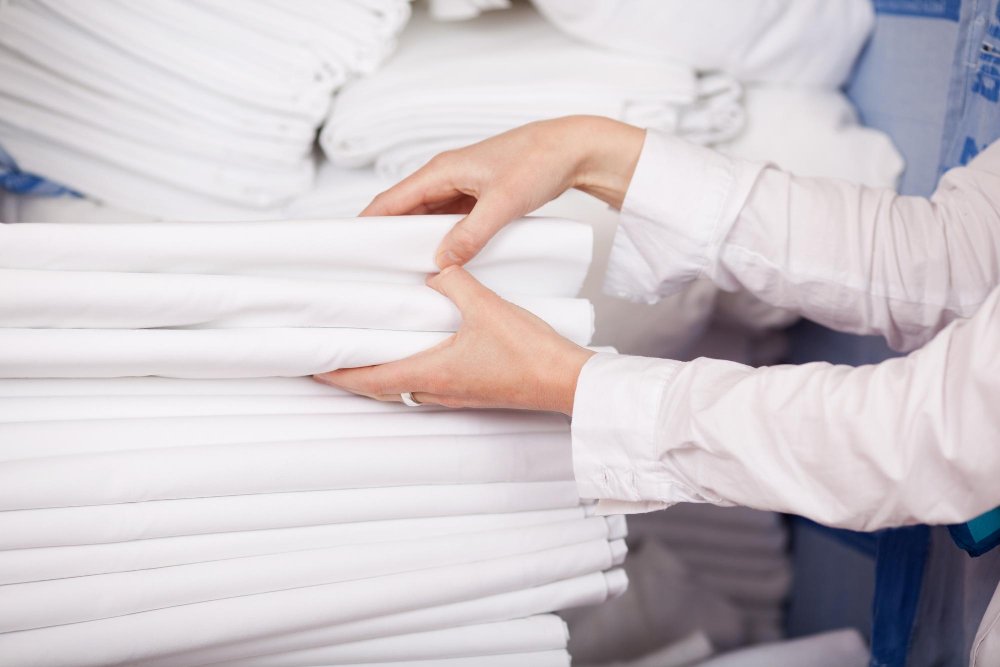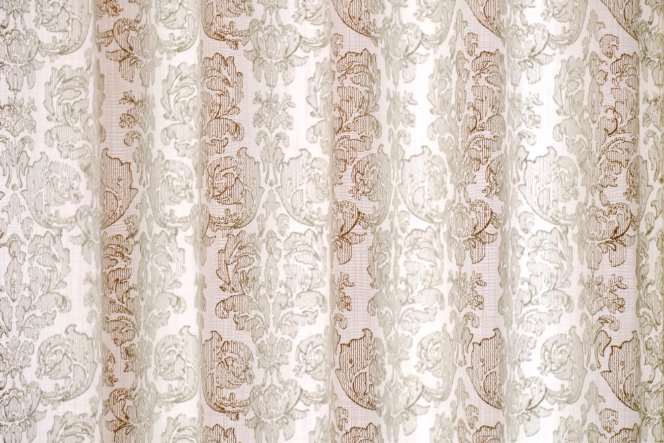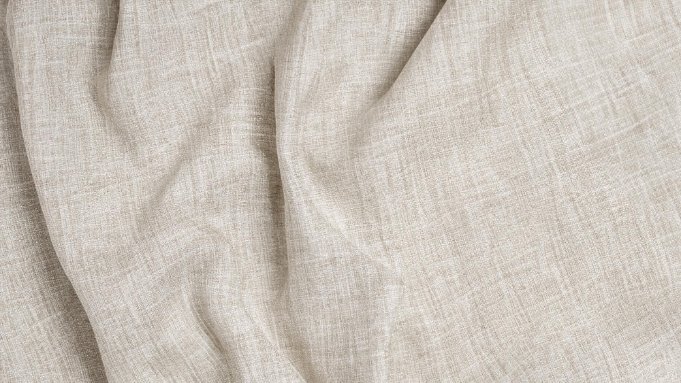Expert Tips for Washing, Drying, and Maintaining Linen Clothes, Bedding, and Home Textiles
Linen clothes and home textiles bring timeless elegance to your wardrobe and living spaces. This natural fabric known for its durability and breathability requires proper care to maintain its beauty and extend its life.
To care for linen properly, wash it in lukewarm water with mild detergent, avoid wringing or twisting the fabric, and separate items by color to prevent fading. The extra attention you give to your linen items will keep them looking fresh and crisp for years to come.
Taking care of linen doesn’t need to be complicated. With some simple steps and gentle handling, you can enjoy the comfort and luxury of this classic fabric while maintaining its natural charm.
Table of Contents
Quick Start: Linen Care Checklist
- ✅ Before washing: Sort by color, check care labels, pre-treat stains
- ✅ Water temperature: Cold to lukewarm (30-40°C/85-100°F)
- ✅ Detergent: Mild, gentle formula without bleach or brighteners
- ✅ Washing: Gentle cycle with plenty of space
- ✅ Drying: Air dry when possible, low heat if using dryer
- ✅ Storage: Cool, dry place away from direct sunlight
- ✅ Download our comprehensive linen care checklist for a printable reference guide you can keep in your laundry room
Understanding Linen Fabric
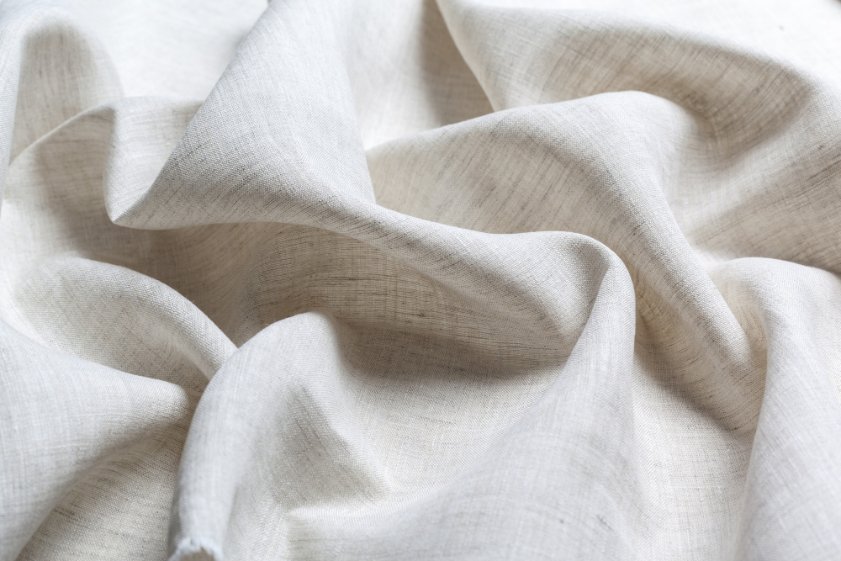
Linen stands as one of nature’s most remarkable textile gifts, known for its exceptional strength and breathability. This timeless fabric becomes softer and more comfortable with each use, making it a favorite for both clothing and home textiles.
History and Heritage
Ancient Egyptians first cultivated flax plants to create linen over 10,000 years ago. The fabric quickly became prized for its cooling properties in hot climates. European nobles later adopted linen as a symbol of wealth and refinement, while Irish and Belgian weavers perfected production techniques in the 1700s, making the fabric more accessible.
What Makes Linen Special
Linen’s unique properties make it ideal for various applications:
Key Characteristics:
- Natural antibacterial properties
- Highly absorbent (holds up to 20% of its weight in moisture)
- Gets stronger when wet
- Naturally hypoallergenic
- Hollow fibers allow excellent airflow
- Develops a beautiful patina over time
Before diving into specific care techniques, watching this comprehensive video guide will give you a visual understanding of proper linen care methods. This expert demonstration covers the essential techniques you’ll be learning in detail throughout this guide:
As you can see in the demonstration, caring for linen is straightforward when you follow the right techniques. Now let’s explore each method in detail so you can master these skills yourself.
Professional textile conservators at the Canadian Conservation Institute note that flax fibers (which create linen fabric) are naturally strong and absorbent, with a lustrous appearance due to the waxes they contain and the long, smooth surface of the fibers. However, they also point out that linen has low resiliency and is prone to wrinkling, with repeated folding into sharp creases potentially causing fiber breakage over time.
Your linen items will naturally resist dirt and stains. Its durability means properly cared for linen pieces can last for decades, making them an excellent investment for your wardrobe and home.
Linen vs. Other Fabrics: Care Comparison
Understanding how linen care differs from other fabrics helps you avoid common mistakes. This comparison shows exactly what makes linen unique:
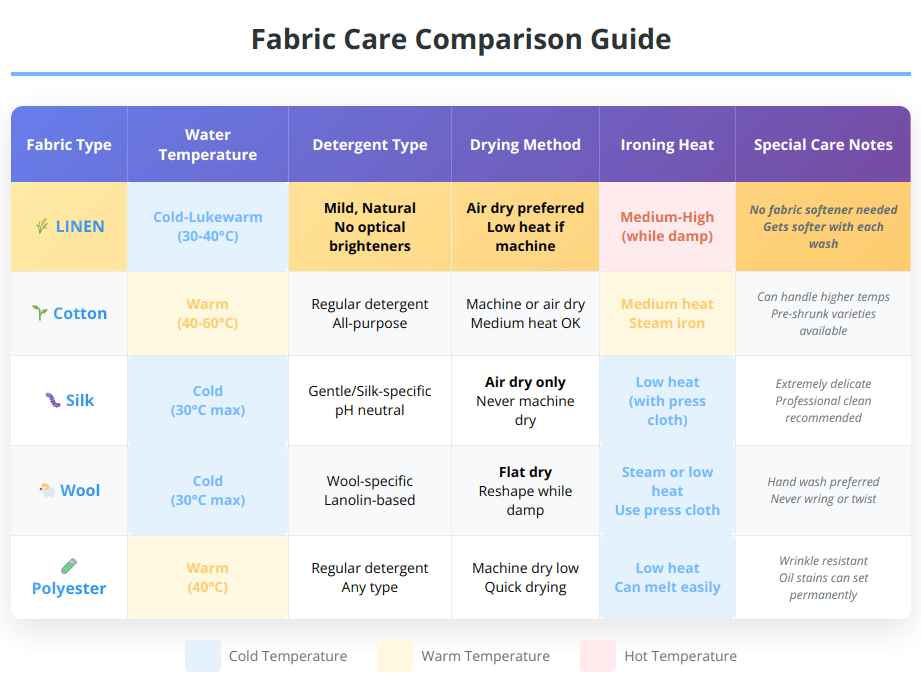
As you can see, linen sits in the middle ground – not as delicate as silk, but requiring more gentle care than cotton or synthetic fabrics.
How to Properly Care for Linen
Understanding the fundamentals of linen care sets the foundation for maintaining your fabric’s beauty and longevity. These core principles apply to all types of linen items:
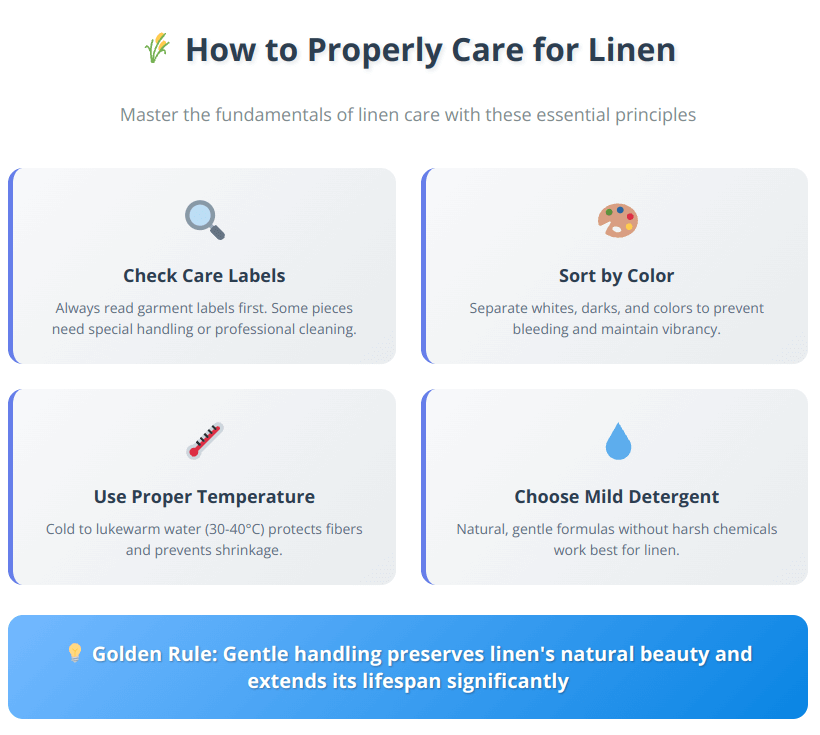
Master these basics first, and you’ll avoid the most common mistakes that damage linen. Let’s explore each principle in detail.
Pre-Washing Preparation
Always check the care label on your garment first. Some linen pieces are pre-washed during manufacturing, making them softer and more tolerant of machine washing, while others may require extra care to avoid shrinkage or damage.
Essential preparation steps:
- Sort linen by color (darks, lights, whites)
- Turn items inside out
- Button up all buttons and zip all zippers
- Check pockets for items
- Pre-treat any visible stains
Not sure about your linen type? Take our fabric identification quiz to get personalized care recommendations.
Can You Put 100% Linen in the Washing Machine?
Yes, most 100% linen items can be safely machine washed. However, always check the care label first, as some structured garments (like blazers) or delicate vintage pieces may require hand washing or dry cleaning.
Machine washing guidelines:
- Use a gentle or delicate cycle
- Wash in cold to lukewarm water (30-40°C/85-100°F)
- Don’t overload the machine
- Use a mesh laundry bag for delicate items
- Separate from heavy items like denim or towels
Choosing the Right Detergent for Linen
The detergent you choose can make or break your linen care routine. Mild, natural detergents work best for preserving linen’s integrity and natural properties. Here’s a clear breakdown of what works best and what to avoid:
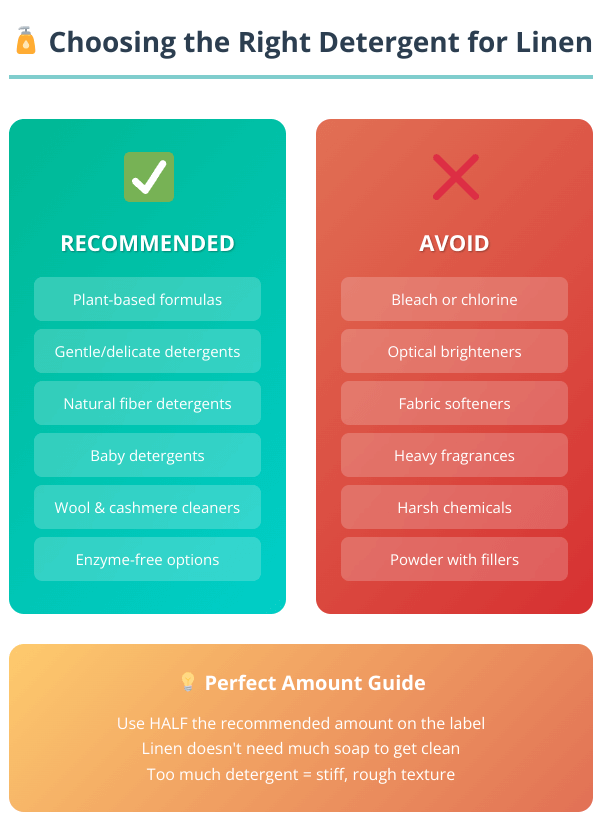
Remember, the goal is to clean gently while preserving linen’s natural properties. When in doubt, less is more with both detergent choice and quantity
What Detergent is Best for Linen?
Recommended detergent types:
- Gentle, plant-based formulas
- Detergents designed for natural fabrics
- Wool and cashmere detergents (they’re gentle enough for linen)
- Baby detergents (free from harsh chemicals)
Products to avoid:
- Bleach or chlorine-based cleaners
- Detergents with optical brighteners
- Heavy perfumed formulas
- Fabric softeners
The American Cleaning Institute, the home of the U.S. cleaning products industry, emphasizes the importance of following fabric care labels and using appropriate detergent amounts. Their research shows that using the correct amount of detergent is crucial – too much can leave residue that makes linen feel stiff, while too little won’t clean effectively.
Use about half the recommended amount of detergent. Linen doesn’t need much soap to get clean, and excess detergent can leave residue that makes fabric feel stiff.
Is 30 Degrees a Cold Wash?
Yes, 30°C (86°F) is considered a cold wash and is perfect for most linen items. This temperature effectively cleans while minimizing shrinkage and color fading. For heavily soiled white linens, you can go up to 40°C (104°F), but avoid higher temperatures.
Water Temperature Guidelines
| Linen Type | Recommended Temperature | Why |
|---|---|---|
| Dark/Colored | 30°C (86°F) | Prevents fading |
| White/Natural | 30-40°C (86-104°F) | Effective cleaning |
| Delicate/Vintage | Cold (below 30°C) | Maximum protection |
| Heavily Soiled | 40°C max (104°F) | Better stain removal |
Never use hot water on linen. Heat can cause significant shrinkage and weaken the fibers over time.
Care labels can be confusing, but understanding the symbols makes linen care much easier. Here’s your complete guide to what each symbol means for linen:
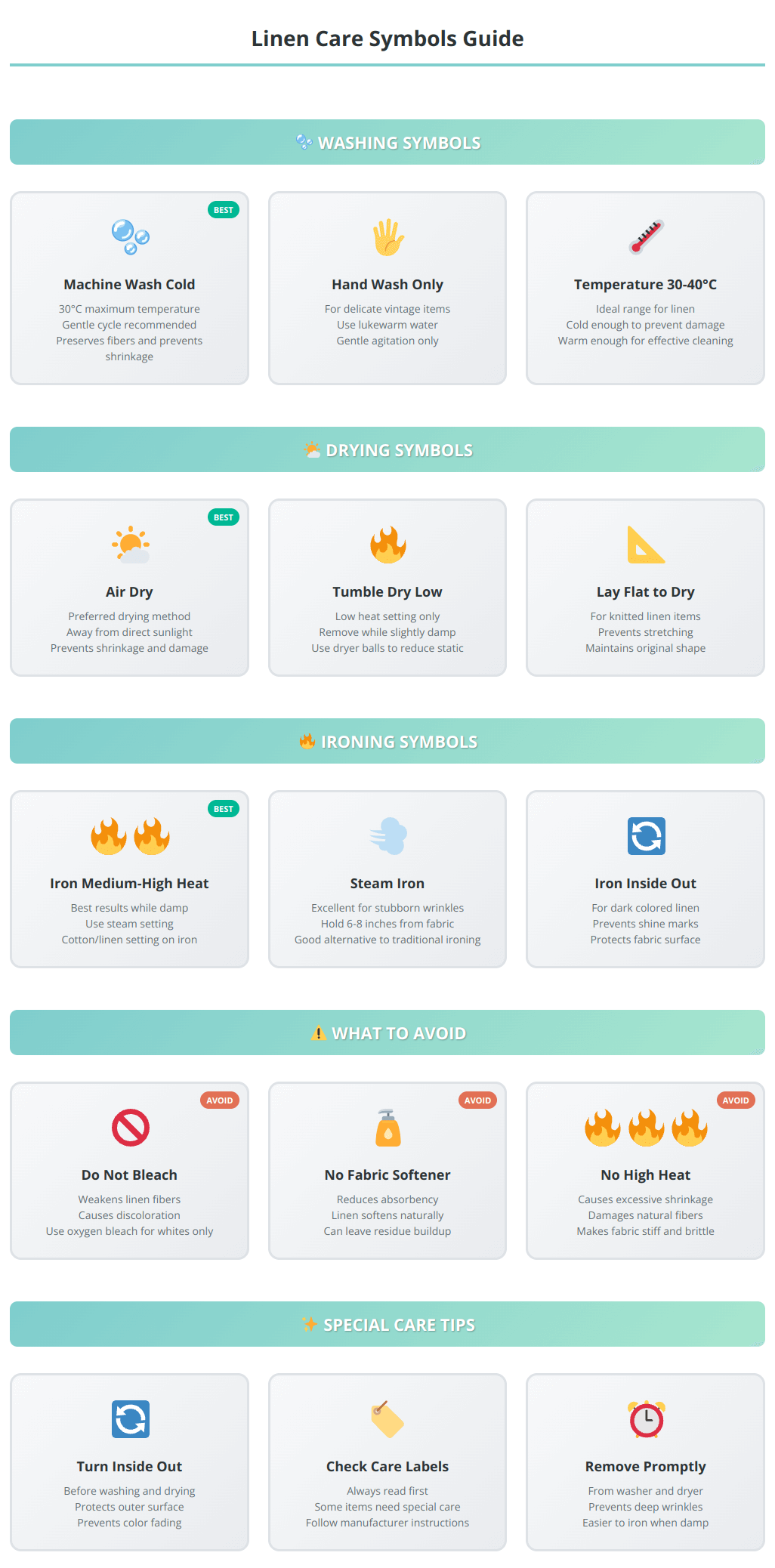
Keep this guide handy when doing laundry. These symbols are your roadmap to proper linen care, helping you avoid damage and achieve the best results every time.
Not sure about temperature conversions? Use our Celsius to Fahrenheit converter tool to find the perfect washing temperature for your linen items.
Hand Washing Techniques
Hand washing is ideal for delicate linen items, vintage pieces, or when you only have a few items to clean.
Step-by-Step Hand Washing
- Fill a basin with lukewarm water and add mild detergent
- Submerge the linen and gently agitate with your hands
- Let it soak for 5-10 minutes for regular soil, up to 30 minutes for heavy stains
- Gently squeeze the fabric without wringing or twisting
- Rinse thoroughly until water runs clear
- Press out excess water by rolling in a clean towel
What not to do:
- Never wring or twist linen when wet
- Don’t scrub or rub vigorously
- Avoid pulling or stretching the fabric
- Don’t leave soaking for hours
Machine Washing Essentials
Following the right sequence makes all the difference in linen care. Here’s your complete step-by-step process from start to finish:
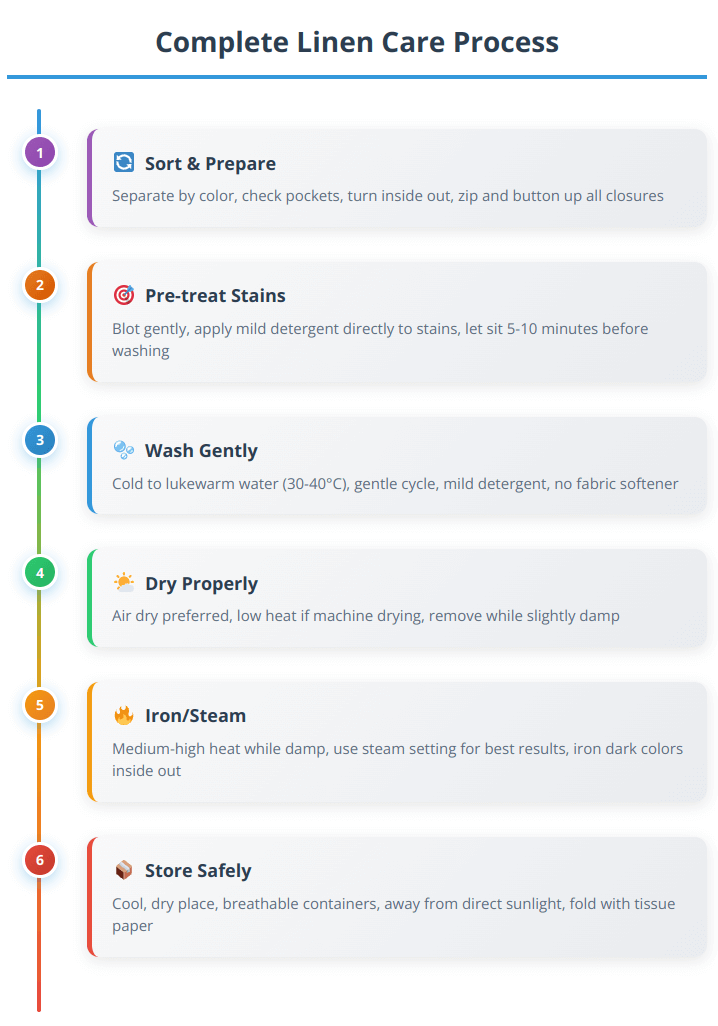
This proven sequence ensures your linen items get the gentle treatment they need while achieving the best possible results. Let’s dive deeper into each step.
Best Practices for Machine Washing
Preparation:
- Use a mesh laundry bag for delicate items
- Select gentle or delicate cycle
- Wash similar colors together
- Leave plenty of space in the machine
Settings:
- Water temperature: Cold to lukewarm
- Spin speed: Low to medium
- Load size: Half to three-quarters full
Important steps:
- Remove items promptly after washing
- Shake out gently before drying
- Never overload the machine
- Skip the extra rinse if possible (reduces wear)
Does Linen Shrink Every Time You Wash It?
Linen typically shrinks most during the first wash, with minimal shrinkage in subsequent washes if you follow proper care guidelines. Expect 3-10% shrinkage on the first wash, but this should stabilize after the initial cleaning.
To minimize shrinkage:
- Always use cold to lukewarm water
- Air dry when possible
- Avoid high heat in both washing and drying
- Consider pre-washing new items in cold water
The Art of Drying Linen
Proper drying is crucial for maintaining linen’s texture and preventing damage. Different methods work best for different situations:
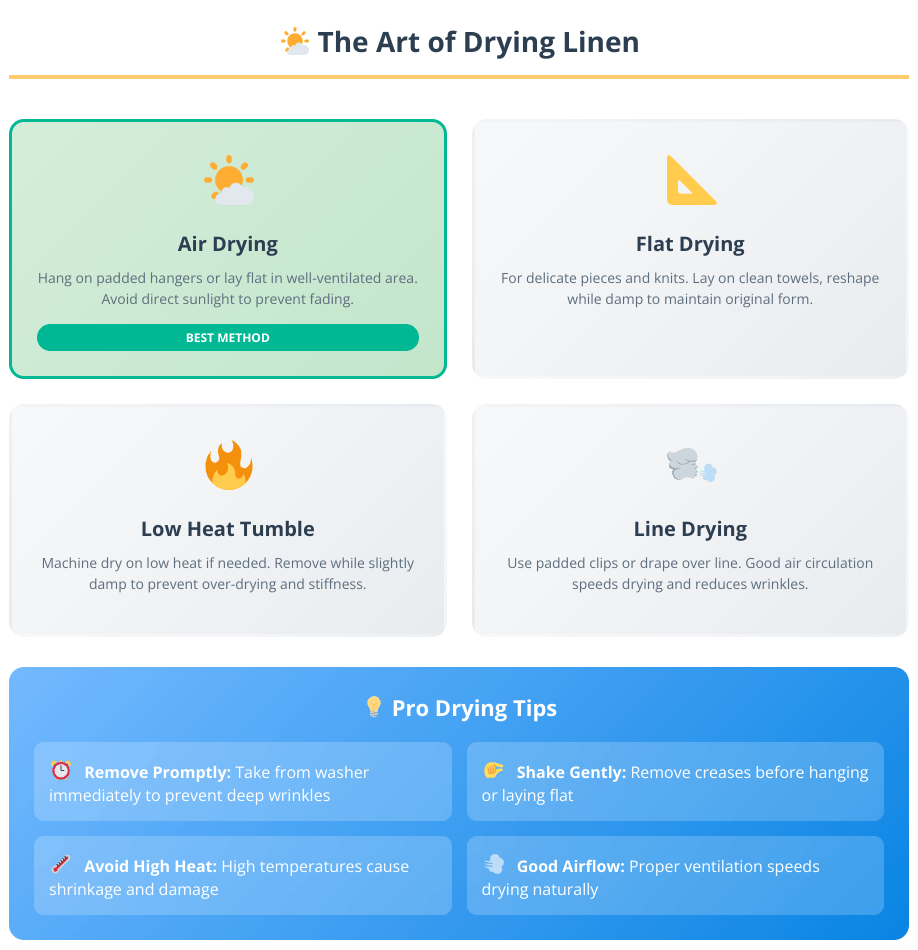
Air drying remains the gold standard, but understanding all methods gives you flexibility based on your situation and time constraints.
Air Drying: The Gold Standard
Air drying is the gentlest and most effective method for linen. Here’s how to do it right:
Best practices:
- Hang items on padded hangers or lay flat
- Choose a well-ventilated area
- Avoid direct sunlight (can fade colors)
- Remove while slightly damp for easier ironing
For different linen items:
- Dresses: Hang by the shoulders on padded hangers
- Shirts: Button the top button and hang properly
- Sheets: Fold over a line, don’t use clothespins
- Table linens: Lay flat on a clean surface
Should Linen be Tumble Dried?
Yes, linen can be tumble dried safely if you use the right settings. Many people think you can’t machine dry linen, but that’s a myth.
Machine drying guidelines:
- Use low or no heat setting
- Remove while slightly damp
- Add wool dryer balls to reduce static
- Clean the lint filter before drying
- Don’t overload the dryer
When to air dry instead:
- Delicate or vintage pieces
- Dark colors (to prevent fading)
- Items with embellishments
- When you have time (it’s gentler)
Avoiding Wrinkles and Stiffness
Why is my linen shirt stiff after washing? Stiffness usually comes from:
- Too much detergent
- Hard water minerals
- Over-drying
- High heat
Solutions:
- Use less detergent
- Add white vinegar to the rinse cycle
- Remove from dryer while damp
- Iron while slightly moist
Hard water minerals can cause stiffness. Learn how your local water conditions affect linen care with our regional care variations guide.
Ironing and Steaming Linen
Does Linen Need to be Ironed?
Not necessarily. Linen’s natural texture includes some wrinkles, and many people embrace this relaxed look. However, if you prefer a crisp appearance, ironing can give excellent results.
Is it Better to Steam or Iron Linen?
Both methods work well, but they serve different purposes:
Ironing is better for:
- Achieving crisp, sharp lines
- Pressing collars and cuffs
- Removing deep-set wrinkles
- Professional or formal appearance
Steaming is better for:
- Quick touch-ups
- Delicate or embellished pieces
- Maintaining natural texture
- Freshening between wears
Both ironing and steaming can give excellent results with linen, but each method has its ideal use cases. Here’s how to choose and execute each approach:
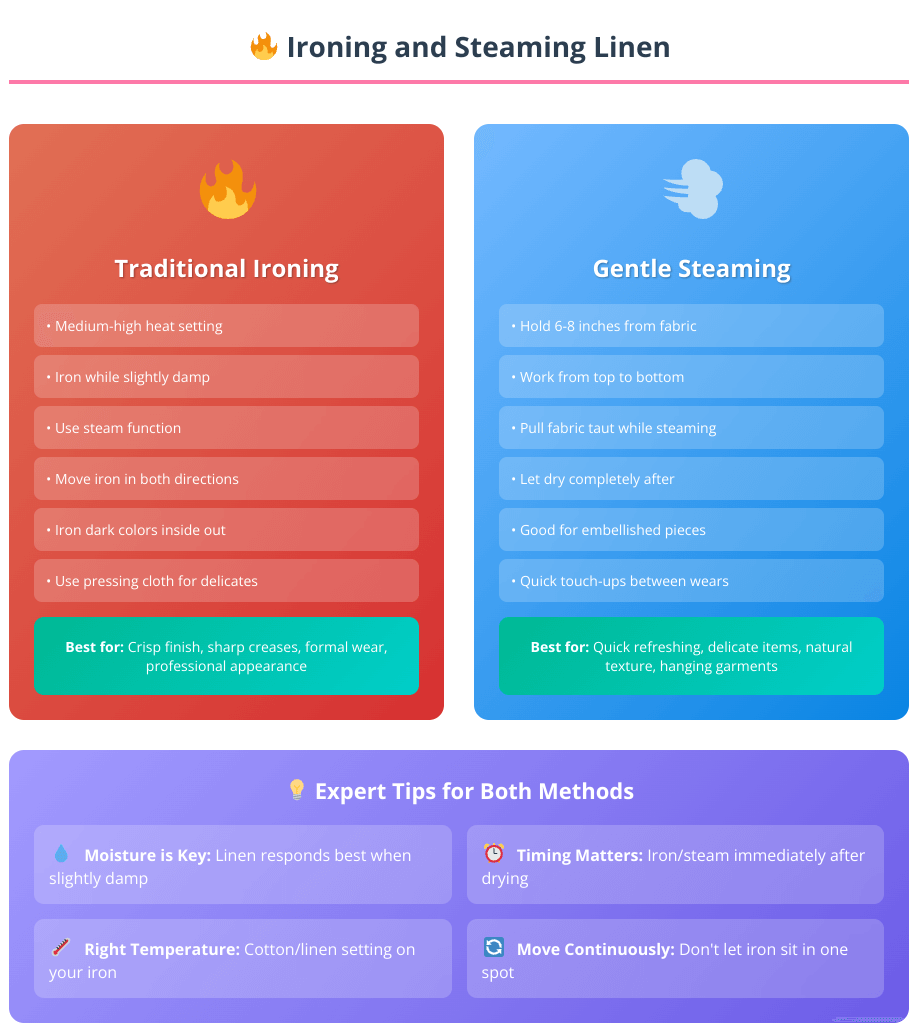
Whether you choose traditional ironing or gentle steaming, the key is working with slightly damp linen and using the right temperature settings.
Ironing Techniques
Best practices:
- Iron while slightly damp
- Use medium-high heat (linen setting)
- Move the iron in both directions
- Use steam for stubborn wrinkles
- Iron dark colors inside out
For different areas:
- Collars: Start from points, work toward center
- Sleeves: Iron flat, then fold along seam
- Body: Work in sections, overlap slightly
- Pleats: Use a pressing cloth for protection
How to Get Wrinkles Out of Linen
Quick methods:
- Damp towel method: Place a damp towel over wrinkled area, iron over it
- Spray bottle: Lightly mist with water, smooth with hands
- Bathroom steam: Hang in bathroom during hot shower
- Dryer refresh: Add a damp towel, tumble on low for 10 minutes
Is it Okay to Wear Wrinkled Linen?
Absolutely! Wrinkled linen is part of its charm and natural character. In fact, the “lived-in” look is often preferred for casual wear. The key is wearing it confidently and ensuring the wrinkles look natural rather than careless.
When wrinkles work:
- Casual summer outings
- Beach or vacation wear
- Weekend relaxation
- Artisanal or bohemian styles
When to iron:
- Business or professional settings
- Formal events
- Special occasions
- When you prefer a polished look
Treating Stains and Problem Areas
Quick action and the right treatment method are essential for removing stains from linen. Here’s your complete emergency response guide and specific solutions for common stains:
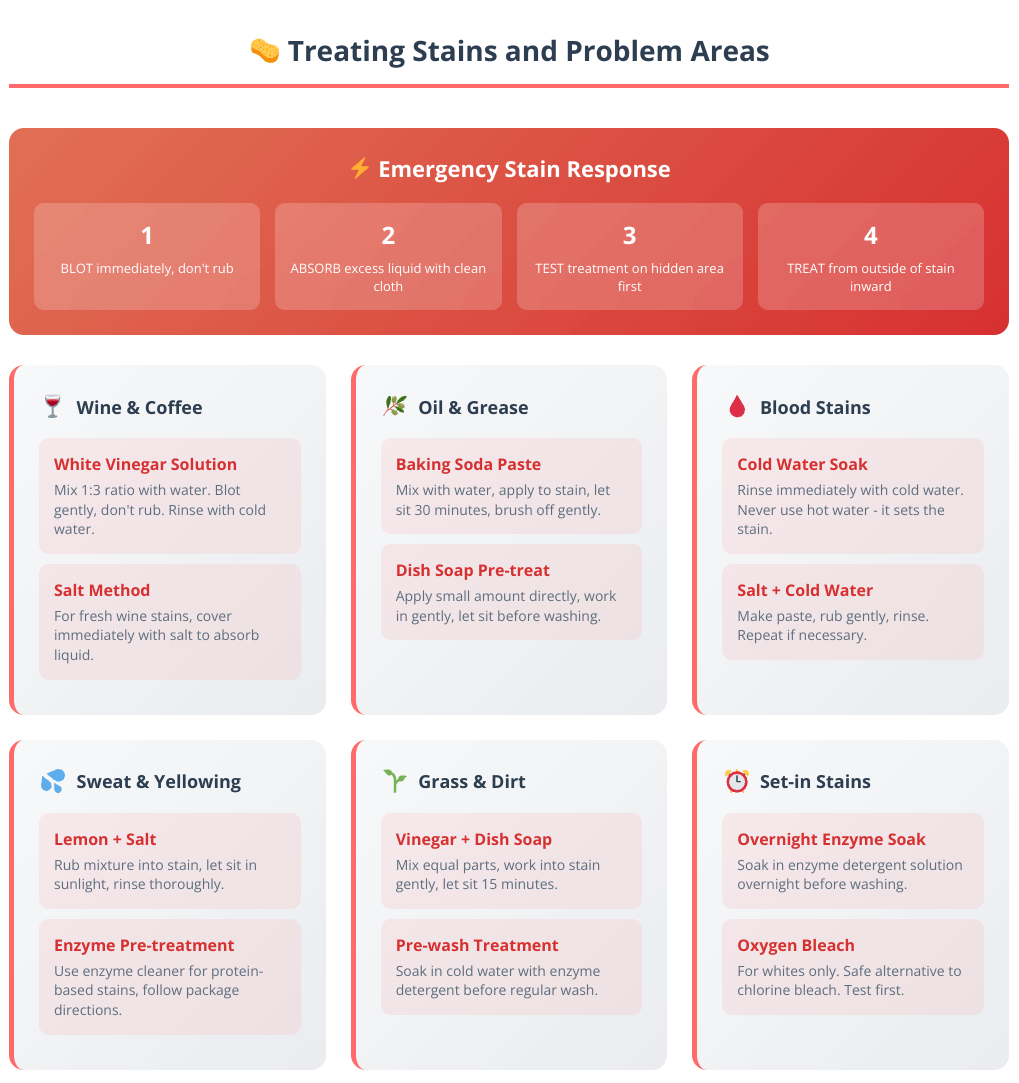
Remember, the faster you act, the better your chances of complete stain removal. When in doubt, test any treatment on a hidden area first.
Pre-Treating Stains
Quick action is essential for linen stain removal. The fabric’s absorbent nature means stains can set quickly if not addressed.
Immediate steps:
- Blot, don’t rub – Use a clean cloth to absorb liquid
- Act fast – Fresh stains come out easier
- Test first – Try cleaning solutions on a hidden area
- Work from outside in – Prevents stain spreading
Natural Stain Removal Methods
Common household solutions:
| Stain Type | Treatment | Method |
|---|---|---|
| Oil/Grease | Baking soda paste | Apply, let sit 30 min, brush off |
| Wine/Coffee | White vinegar solution | 1:3 ratio with water, blot gently |
| Sweat/Yellowing | Lemon juice + salt | Rub in, let sit in sun, rinse |
| Blood | Cold water + salt | Soak immediately, rinse with cold water |
| Grass | Dish soap + vinegar | Mix equal parts, work in gently |
How to Get Old Stains Out of Linen
For set-in stains, you’ll need more intensive treatment:
- Soak overnight in cool water with enzyme detergent
- Make a paste with baking soda and water for protein stains
- Use oxygen bleach (color-safe) for white linens only
- Try commercial stain removers designed for natural fibers
- Repeat treatment if necessary before final wash
Professional help: For valuable vintage pieces or stubborn stains, consider professional cleaning.
Proper Storage Techniques
Proper storage protects your linen investment and extends its lifespan significantly. Different types of linen items require specific storage approaches:
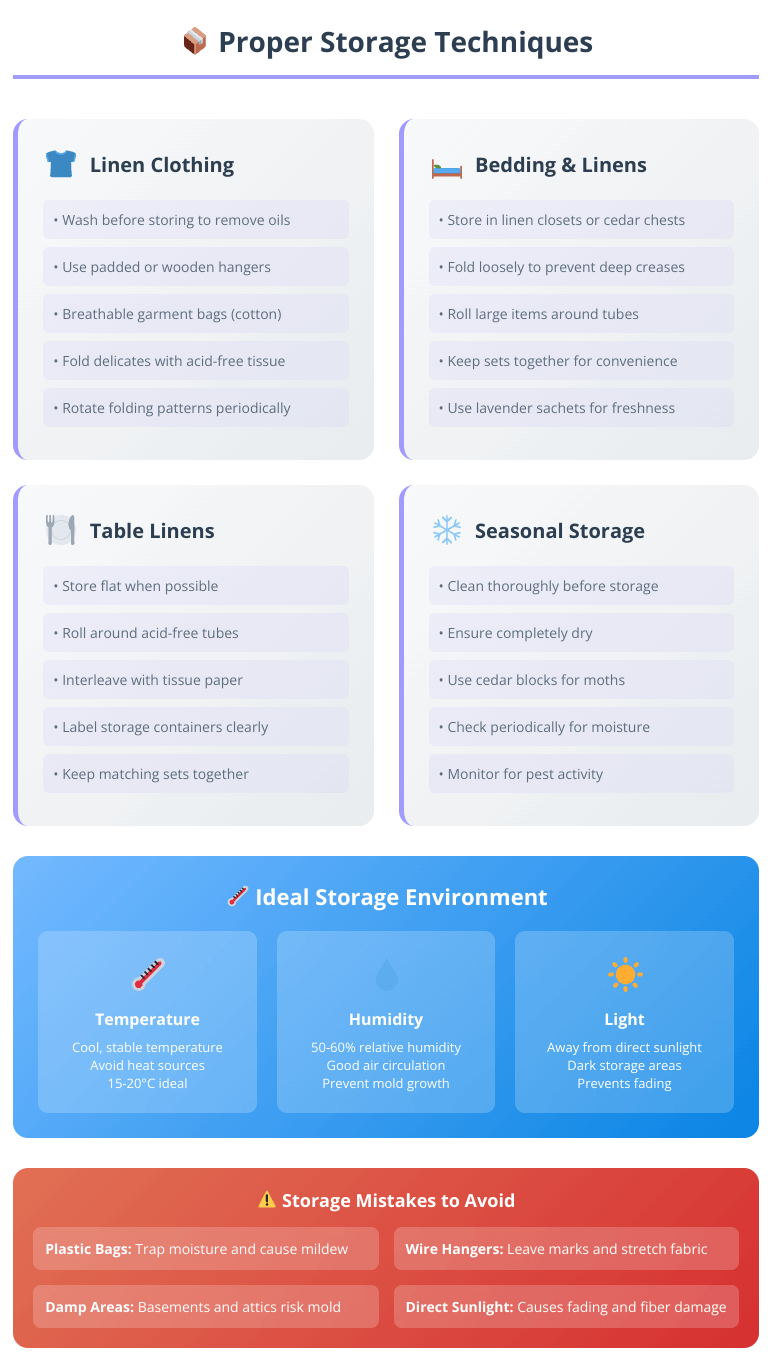
Good storage habits prevent damage, maintain freshness, and make your linens ready to use whenever you need them. The extra effort pays off in longevity.
Best Practices for Linen Clothing
Preparation for storage:
- Wash all items before storing
- Ensure everything is completely dry
- Check for and treat any stains
Storage methods:
- Use breathable garment bags (cotton, not plastic)
- Hang on padded or wooden hangers
- Fold delicate pieces with acid-free tissue paper
- Store in cool, dry areas with good air circulation
What to avoid:
- Direct sunlight
- Damp areas (basements, attics)
- Plastic bags (trap moisture)
- Wire hangers (can leave marks)
Storing Linen Bedding and Table Linens
For sheets and pillowcases:
- Fold loosely to prevent deep creases
- Rotate folding patterns periodically
- Store in linen closets or cedar chests
- Use lavender sachets for natural freshness
For tablecloths and napkins:
- Roll large pieces around acid-free tubes
- Store flat when possible
- Keep sets together for convenience
- Label storage containers clearly
Seasonal Storage Tips
Summer storage (when not in use):
- Clean thoroughly before storing
- Use breathable storage bags
- Add cedar blocks or lavender to deter moths
- Check periodically for moisture
Winter preparation:
- Ensure proper ventilation in storage areas
- Avoid areas with temperature fluctuations
- Keep away from heating sources
- Monitor for pest activity
Advanced Linen Care Tips
Take your linen care to the next level with these expert techniques. These advanced methods help you achieve professional-quality results at home:
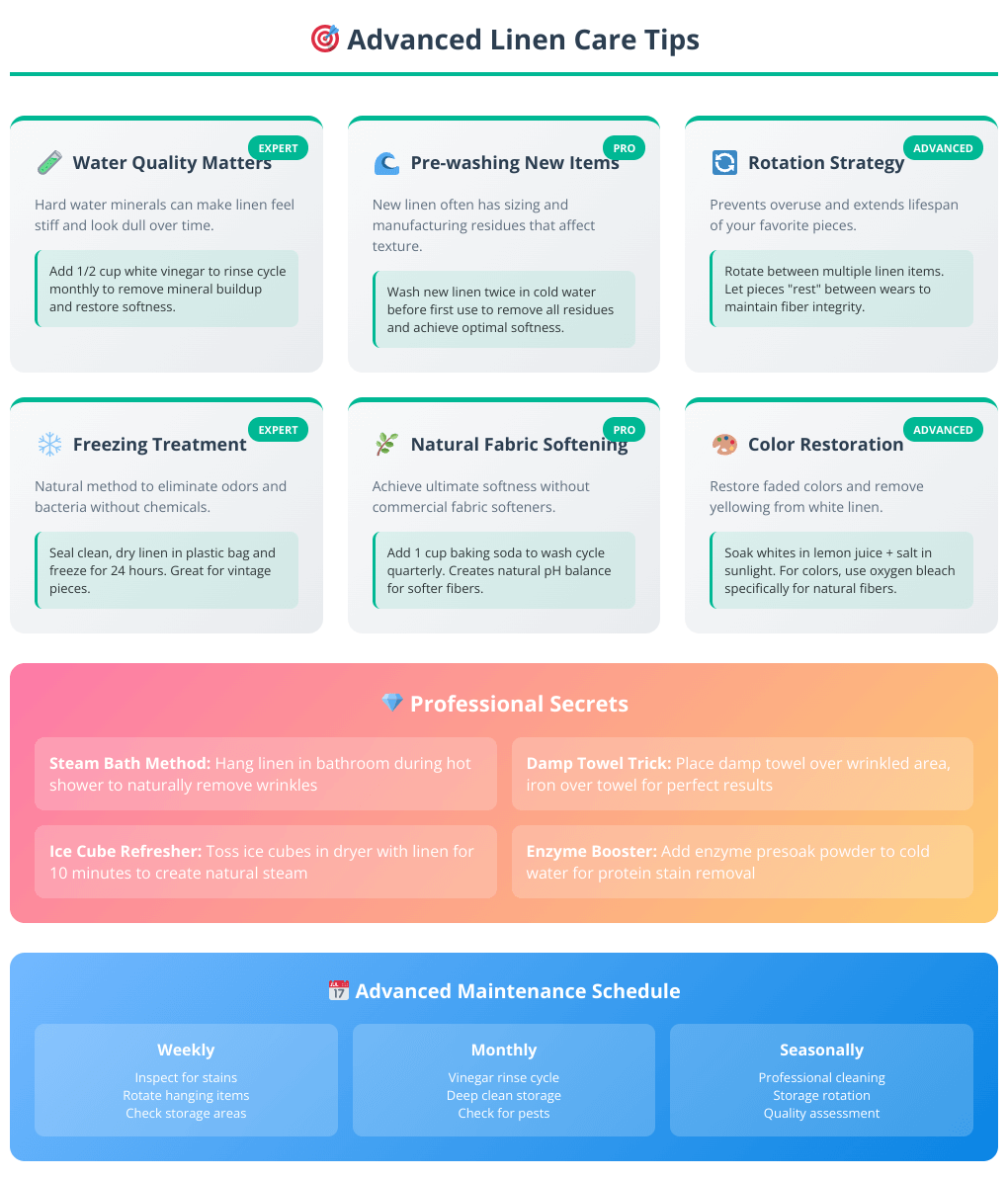
These advanced techniques might seem complex, but they’re what separate good linen care from exceptional results. Start with one or two methods and build your expertise gradually.
How to Keep Linen Looking New
Regular maintenance:
- Wash after 2-3 wears (depending on use)
- Address stains immediately
- Rotate pieces to prevent overuse
- Store properly between seasons
Long-term care:
- Professional cleaning once yearly for special pieces
- Steam or iron regularly to maintain shape
- Replace hangers if they leave marks
- Keep away from harsh chemicals
Does Linen Get Softer the More You Wash It?
Yes! This is one of linen’s best qualities. Each wash breaks down the fibers slightly, making them more flexible and comfortable. However, follow proper care techniques to ensure the softening process doesn’t lead to premature wear.
Why linen softens:
- Natural fiber structure becomes more flexible
- Washing removes sizing and manufacturing residues
- Gentle agitation relaxes tight weaves
- Natural oils from use condition the fibers
Why Does Baking Soda Soften Linen?
Baking soda works as a natural fabric softener by:
- Neutralizing acidic residues from detergents
- Breaking down mineral deposits from hard water
- Balancing pH levels in wash water
- Removing odors that can make fabric feel stiff
How to use: Add 1/2 cup baking soda to the wash cycle with your regular detergent
Troubleshooting Common Issues
Even with the best intentions, linen care can sometimes go wrong. Here are the most common problems and their proven solutions:
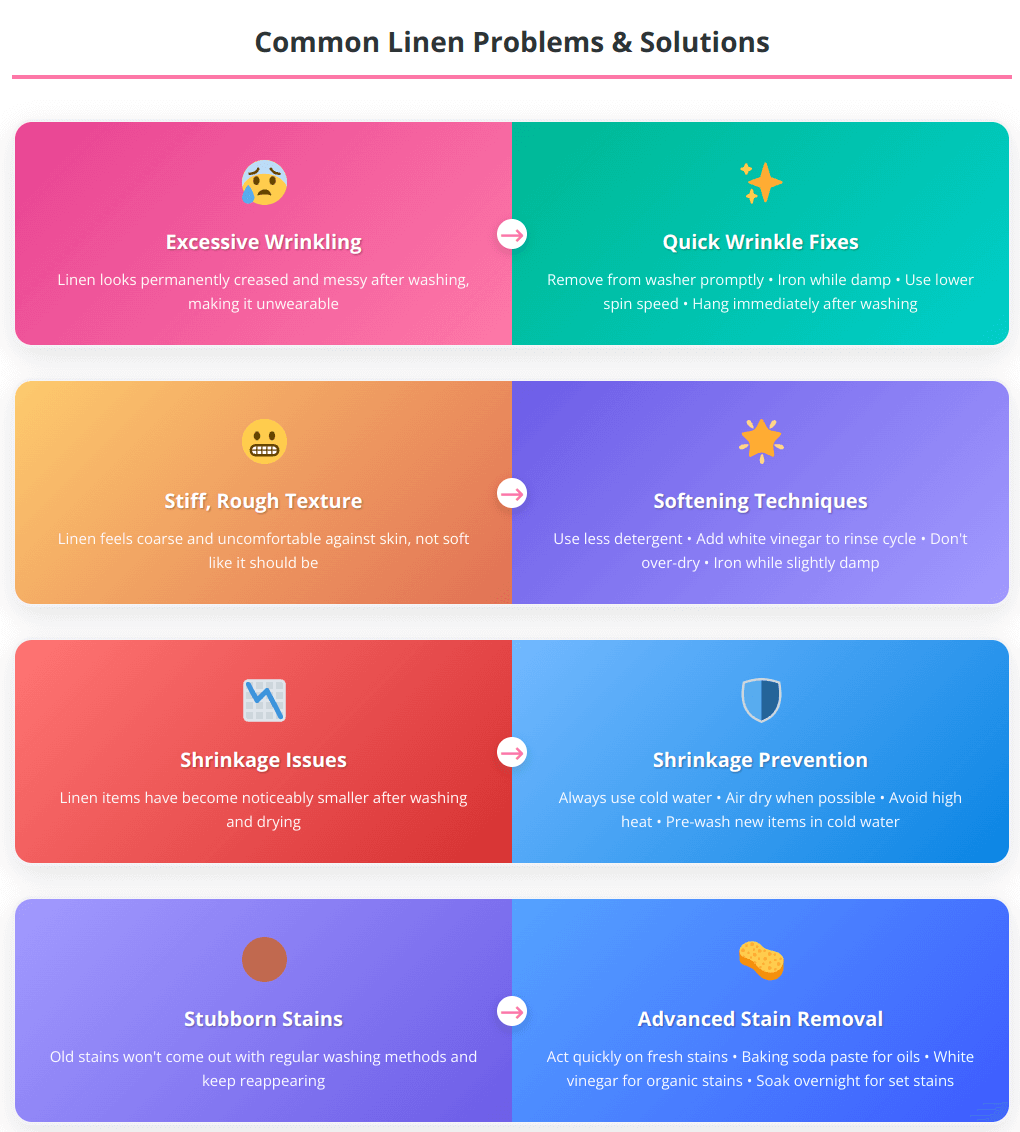
Remember, most linen problems are preventable with the right techniques. When issues do arise, these solutions will help restore your linen to its best condition.
Why is Linen Always Wrinkled?
Wrinkling is natural for linen due to its fiber structure. Unlike synthetic fabrics that have built-in wrinkle resistance, linen fibers are designed to move and flex, which creates creases.
Factors that increase wrinkling:
- High humidity
- Overpacking in storage
- Aggressive washing cycles
- Over-drying
Reduction strategies:
- Remove from washer promptly
- Use lower spin speeds
- Hang or fold immediately after drying
- Store with proper spacing
When Should You Stop Wearing Linen?
Traditionally, linen was considered a summer fabric, but modern fashion has no strict rules. However, consider these guidelines:
Best seasons for linen:
- Spring and summer (classic choice)
- Early fall in warm climates
- Year-round in tropical locations
- Layered pieces in transitional weather
Less ideal times:
- Heavy winter conditions
- Formal business environments requiring crisp appearance
- When professional pressing isn’t possible
Should You Wash Linen After Every Use?
Not necessarily. Linen’s natural antibacterial properties mean it stays fresh longer than many fabrics.
Wash frequency guidelines:
- Underwear/intimates: After each wear
- Shirts/blouses: After 2-3 wears
- Pants/skirts: After 3-4 wears (depending on activity)
- Jackets/blazers: Spot clean as needed, wash less frequently
- Bedding: Weekly or bi-weekly
- Table linens: After each use or when stained
Signs it’s time to wash:
- Visible stains or spots
- Noticeable odors
- Feels stiff or dirty
- Has lost its fresh appearance
Determine the perfect washing frequency for your lifestyle with our personalized care schedule calculator.
Understanding Linen Quality and Cost
Understanding what drives linen pricing helps you make informed purchases and appreciate the value of quality pieces. Here’s how different quality levels compare:

While quality linen requires a higher initial investment, the longevity, comfort, and timeless appeal make it a smart choice for discerning buyers.
Why is Linen So Expensive?
Several factors contribute to linen’s higher price point:
Production complexity:
- Labor-intensive flax cultivation
- Complex processing from plant to fiber
- Limited growing regions (mostly Europe)
- Specialized manufacturing equipment
Quality factors:
- Fiber length (longer = higher quality)
- Weave tightness and consistency
- Finishing processes
- Brand reputation and craftsmanship
Value proposition:
- Exceptional durability (can last decades)
- Improves with age and use
- Timeless style that doesn’t go out of fashion
- Natural, sustainable material
What is Better: Cotton or Linen?
Both fabrics have their advantages:
Linen advantages:
- More breathable and cooling
- Naturally antibacterial
- Gets softer with each wash
- More durable when cared for properly
- Better moisture-wicking properties
Cotton advantages:
- Generally less expensive
- Easier to care for
- More wrinkle-resistant options available
- Wider variety of weights and textures
- More color-fast options
The choice depends on your priorities: comfort and durability (linen) vs. convenience and cost (cotton).
Want to identify your linen’s quality grade? Our linen quality identifier tool helps you determine the exact care your fabric needs.
Special Care Situations
Some linen items require modified care approaches based on their construction, age, or special features. Here’s how to handle these unique situations:

When dealing with special linen items, err on the side of caution. It’s better to be overly gentle than risk damage to irreplaceable pieces.
Taking Care of 100% Linen
Pure linen requires the most careful handling but also offers the best benefits:
Special considerations:
- More prone to shrinkage than blends
- Wrinkles more easily
- May require professional care for structured garments
- Benefits most from air drying
Advantages:
- Longest lifespan
- Best breathability
- Most authentic linen experience
- Softest after break-in period
Caring for Linen Blends
Linen blends (cotton-linen, linen-rayon, etc.) often offer easier care:
Common blends and care:
- Linen-cotton: Follow linen care guidelines
- Linen-polyester: Can handle slightly higher temperatures
- Linen-viscose: Requires gentle care like pure linen
- Linen-silk: Hand wash or professional clean
Vintage and Heirloom Linen Care
Antique or family heirloom linens need special attention:
Assessment first:
- Check for weak spots or tears
- Test colorfastness in hidden areas
- Look for previous stain treatments
- Evaluate overall condition
Gentle approach:
- Hand wash in cool water
- Use pH-neutral detergents
- Air dry only
- Consider professional restoration for valuable pieces
Environmental Considerations
Linen is naturally one of the most sustainable fabrics available, and your care methods can enhance or diminish this environmental benefit:
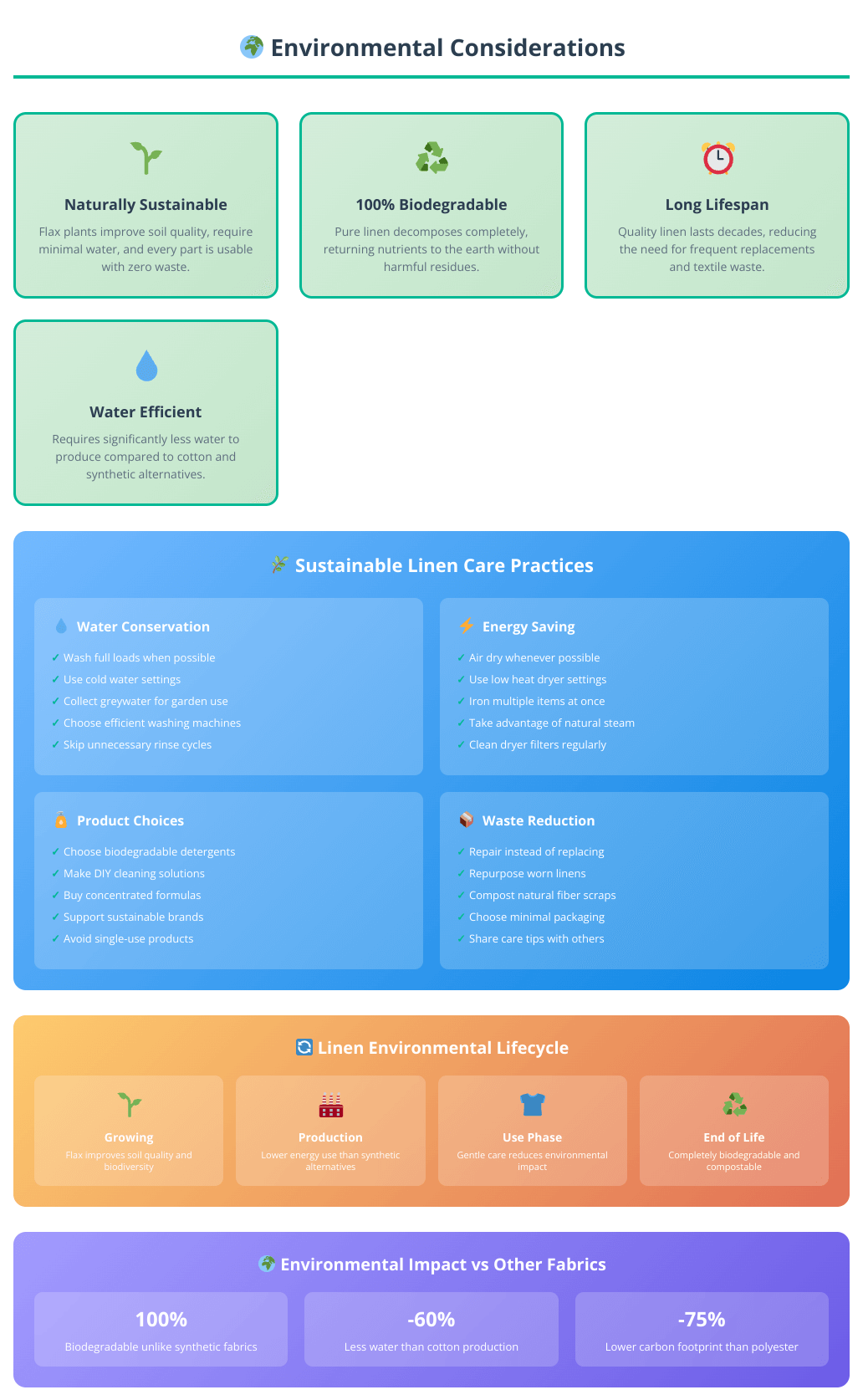
By choosing linen and caring for it sustainably, you’re making a positive environmental impact that extends far beyond your wardrobe.
Sustainable Linen Care Practices
Linen is naturally eco-friendly, and you can enhance this with sustainable care practices:
Water conservation:
- Wash full loads when possible
- Use cold water settings
- Collect rainwater for watering plants with rinse water
- Choose efficient washing machines
Energy saving:
- Air dry whenever possible
- Use low heat dryer settings
- Iron multiple items at once
- Take advantage of natural steam (bathroom method)
Product choices:
- Choose biodegradable detergents
- Make your own cleaning solutions
- Buy concentrated formulas to reduce packaging
- Support brands with sustainable practices
The Linen Lifecycle
Understanding linen’s environmental impact helps you make better care decisions:
Production: Flax plants actually improve soil quality and require less water than cotton
Use phase: Proper care extends lifespan, reducing need for replacement
End of life: Pure linen is completely biodegradable and compostable
Care impact: Gentle, low-temperature washing reduces environmental footprint
Professional vs. Home Care
Deciding between professional cleaning and home care depends on several factors. Here’s a comprehensive guide to help you make the right choice:
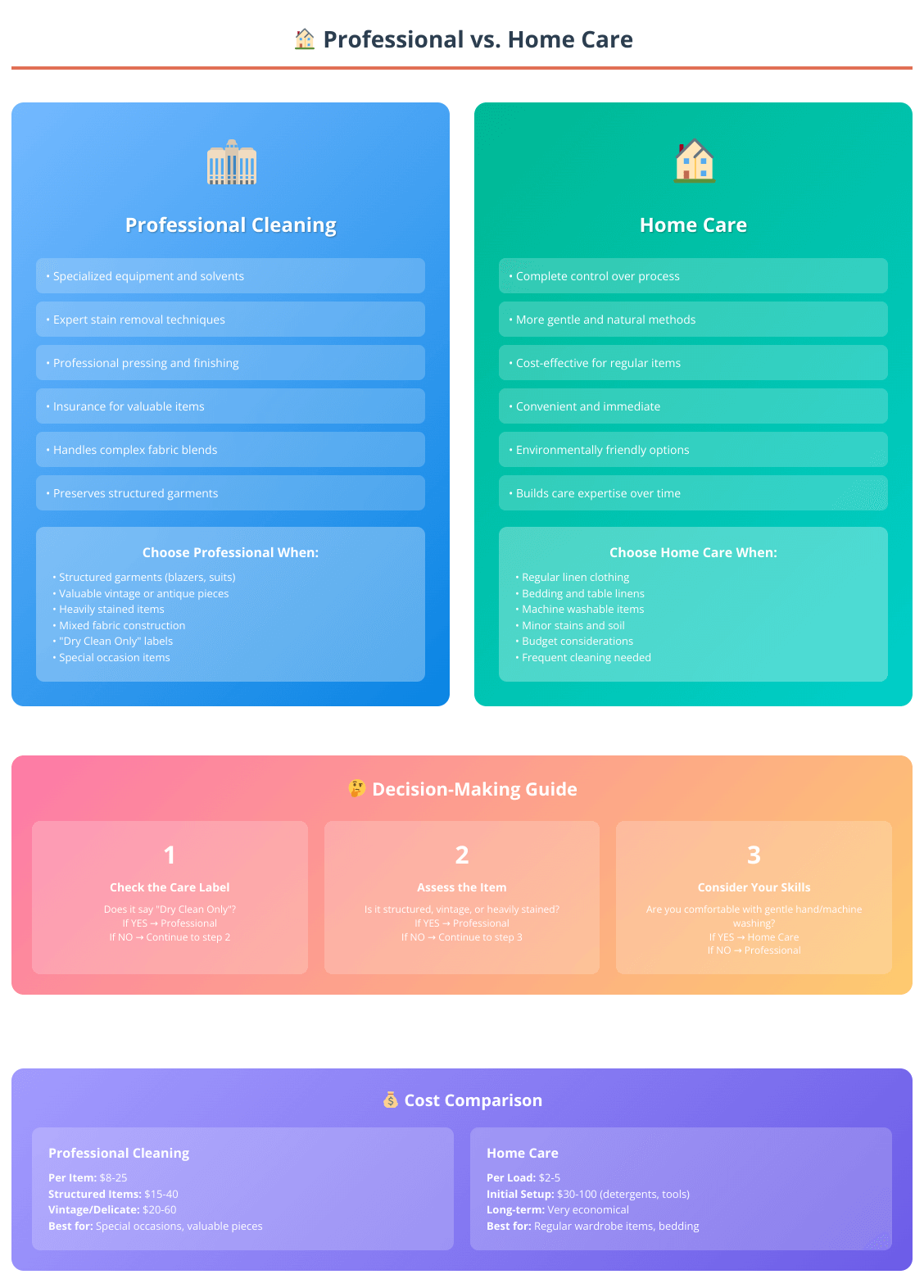
The best approach often combines both methods, professional care for special pieces and home care for everyday items. Build your skills gradually and you’ll save money while achieving excellent results.
When to Choose Professional Cleaning
Situations requiring professional care:
- Structured garments (blazers, tailored pieces)
- Valuable vintage or antique items
- Heavily stained pieces
- Items with mixed fabric construction
- When care labels specify “dry clean only”
Benefits of professional care:
- Specialized equipment and solvents
- Expert stain removal techniques
- Proper pressing and finishing
- Insurance for valuable items
Maximizing Home Care Success
Investment in quality tools:
- Good iron with steam function
- Steamer for quick touch-ups
- Quality hangers and storage solutions
- Gentle, appropriate detergents
Building skills:
- Practice ironing techniques
- Learn to identify different stain types
- Understand your water hardness
- Develop a routine for regular care
For businesses or bulk items, explore our guide to commercial linen care services and find the right professional cleaning solution
Frequently Asked Questions
Can linen be ironed?
Yes, linen can and should be ironed for a crisp appearance. Use medium-high heat and iron while the fabric is slightly damp for best results. Always iron dark colors inside out to prevent shine.
Does water ruin linen?
No, water doesn’t ruin linen. However, hot water can cause shrinkage, and leaving wet linen bunched up can cause permanent wrinkles. Always use appropriate water temperatures and handle wet linen gently.
What are the main disadvantages of linen?
The primary disadvantages include: tendency to wrinkle easily, initial stiffness that requires breaking in, potential for shrinkage if not cared for properly, and higher cost compared to synthetic alternatives.
How to wash linen so it doesn’t wrinkle?
To minimize wrinkles: use cool water, gentle cycle, don’t overpack the machine, remove promptly after washing, shake items out before drying, and hang or lay flat immediately.
Does linen always shrink when washed?
Linen typically shrinks 3-10% on the first wash, but this stabilizes with proper care. Pre-washed linen shrinks less. Using cold water and air drying minimizes shrinkage.
When can you no longer wear linen?
There’s no strict rule, but linen is best in warm weather. In colder climates, it’s traditionally worn from spring through early fall. Modern fashion allows year-round linen wear with appropriate layering.
How to keep linen fresh?
Keep linen fresh by washing appropriately (not too often), storing in breathable containers, using natural fresheners like lavender, and ensuring items are completely dry before storage.
How to treat linen so it doesn’t wrinkle?
You can’t completely prevent wrinkles in linen, but you can minimize them with proper washing, immediate removal from machines, appropriate storage, and embracing the natural texture as part of linen’s charm.
Confused by conflicting linen care advice? Our myth-busting guide separates fact from fiction in linen care.
Conclusion
Caring for linen doesn’t have to be intimidating. This natural fabric rewards proper care with improved softness, durability, and timeless appeal. The key principles are simple: use gentle methods, avoid high heat, and embrace linen’s natural characteristics rather than fighting against them.
Key Takeaways for Successful Linen Care:
- Temperature matters most: Cold to lukewarm water (30-40°C) protects fibers and prevents shrinkage while still cleaning effectively.
- Gentle handling pays off: Whether washing by hand or machine, treat linen with care. Avoid wringing, twisting, or aggressive agitation that can damage the natural fibers.
- Air drying is ideal: While machine drying is possible on low heat, air drying preserves linen’s integrity and prevents over-drying that leads to stiffness.
- Embrace the wrinkles: Linen’s naturally relaxed texture is part of its charm. Perfect pressing isn’t always necessary, and the “lived-in” look is often preferred.
- Quality products matter: Invest in mild, natural detergents and proper storage solutions. Your linen will reward this investment with years of beautiful wear.
- Prevention beats correction: Address stains immediately, store properly, and maintain regular (but not excessive) washing schedules to keep your linen looking its best.
Final Recommendations:
Start with these basic care practices and adjust based on your specific items and lifestyle needs. Remember that linen improves with age and proper care, so the time you invest in learning these techniques will pay dividends in the longevity and beauty of your linen pieces.
Whether you’re caring for a favorite summer dress, luxury bedding, or family heirloom table linens, these guidelines will help you maintain linen’s natural beauty while enjoying all the benefits this remarkable fabric has to offer.
With proper care, your linen items can last for decades, becoming softer and more comfortable with each wash while maintaining their elegant, timeless appeal. The investment in quality linen and proper care techniques will serve you well for years to come.

